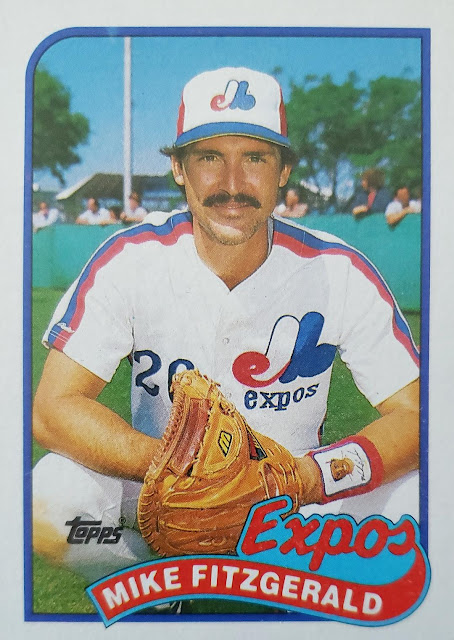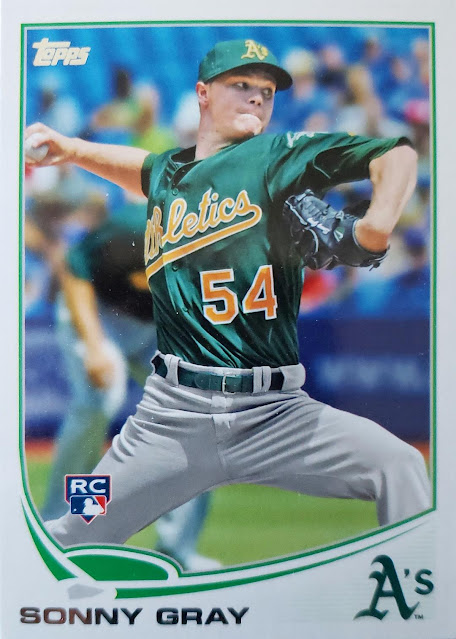I was looking at a football card on one of the online shopping sites the other day. It wasn't anything I sought out, it just caught my eye.
As often happens with football cards, I didn't know the set and I didn't know the player (I don't remember what card it was now). But I was curious about him and I quickly looked for what position he played.
But there was no position listed on the front. That annoyed me (it doesn't take much).
It's been a long time since I've written about positions on the front of baseball cards and I touched on this once awhile ago, so I figured it was time for another one. Let's do a little examination of sets that have not put the position on the front of their cards.
This will mostly cover Topps because as often happens with these historical card reviews, I get to the 1990s and it's just a mess and would take an army of spreadsheets to sort out, and, guys, I still have a full-time job.
But I will mention that Bowman proudly ignored a player's position on the front of its cards for a long time, from the late 1940s until, I believe, 1998 when the position first showed up on the lower left in that set (of course, there was a big gap when Bowman didn't issue any cards).
Topps also didn't put a player's position on the front for its first two sets, 1951 and 1952. That changed with the 1953 set and Topps stayed with it. It became tradition for a baseball card to provide the player's name, team and position on the front. It was like that every year, until one year it wasn't.
I'm pretty sure I've heard collectors say they don't like 1972 Topps because there's no player position on the front. I won't go that far. I love the look of this set way too much for that. But it does seem a little odd even after all these years and I can imagine the card seeming a little naked when packs were first being opened in 1972.
Topps quickly went back to showing positions on the front the very next year and it started a period when they really went all-in on that position designation. We were coming up on my childhood collecting period and I always knew where to look for the position, Topps marked it off so well. Here's the rundown:
1973: silhouette position guy
1974: position in the pennant
1975: position in the baseball
1976: a different position guy
1977: position in the flag
1978: position in the baseball
Only in 1979 was the position listing a little less "honored". Then the position returned to the flag in 1980 and had an entire hat drawing dedicated to it in 1981.
The position continued to enjoy a starring role on the front until another well-known set arrived, 15 years after the previous set with no position.
1987 kicked off a period for Topps, which happened to coincide with the junk wax era, in which the position didn't show up on the front for every set except 1991.
I don't know if Topps made a deliberate decision to skip the position on card fronts at this time. Topps' competition was still showing positions on the front. It wasn't until 1992 that Upper Deck first didn't have a position on the front. But with the arrival of "premium sets," mention of the position was one of the first things to go for sets like Stadium Club.
The position did come back for Topps for a couple of years after 1993 but then it disappeared again for a little while.
The position vanished in 1996 and, except for 2000, did not show up again until 2003. This no-position period coincides with an era that also is a low point for Topps flagship designs. I don't think the lack of position contributes to that feeling, but it doesn't help.
From this point, Topps' decision to add the position on the front skips around from year-to-year. It appears in 2003 and 2004, disappears in 2005 (though the team name is shown twice), appears in 2006, disappears in 2007, 2008, 2009, reappears in 2010 and 2011.
But then, 11 years ago, something happened. An angry email perhaps? This is the last Topps flagship set that did not show a position on the front:
It was so long ago that Sonny Gray was a rookie. 2013 is the last flagship set to ignore the position on the front.
The string of Topps sets with the position, from 2014-2024, is the longest since the run from 1973-86 and the third-longest streak in Topps' history.
I don't need the position to show up on the front for me to like the set -- 1972 and 2013 Topps are both two favorites -- but generally I think it doesn't hurt to get it on the front every year, it's not like it takes up a bunch of space.
I know from my experience with that one football card that it might help tell the story about that player to an unfamiliar collector. Outside of the photo, it's the best identifying feature about the player on the front of a card. (P.S.: If the player's in catching gear, you probably don't need the position logo for help).







Comments
I just made the connection the 1990 set is just a reimage of 1987 Topps - I always thought it was the response to 1989 Donruss.
With more recent cards (and as a card designer) I've found myself sort of questioning the relevance of the position indicator due to the amount of platoons and the way so many of the players are basically utility players.
On another note, I also like the player’s uniform number on a card, too. Especially the way 2003 Upper Deck did it.
One more thing: I finally found a complete set of 2002 Victory. It took over 20 years. This is no joke.
The 72s with the brilliant color schemes were so unique for the time that the lack of position doesn't bother me at all. Plus 787 cards was cool when I put together a later exmt set.